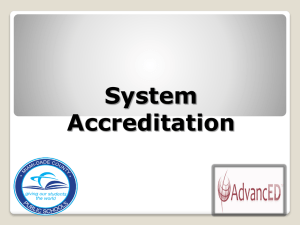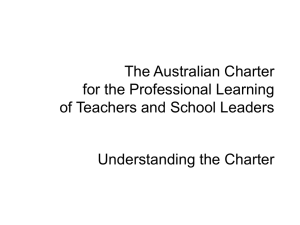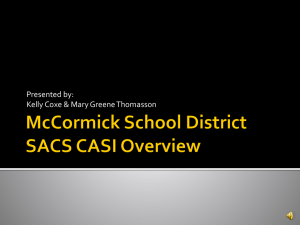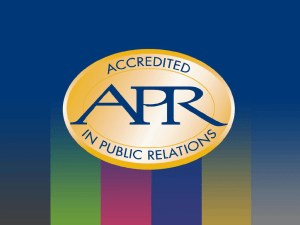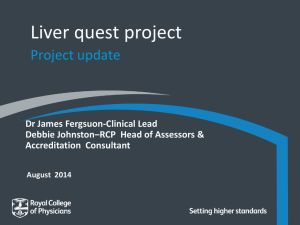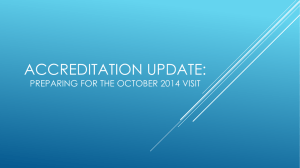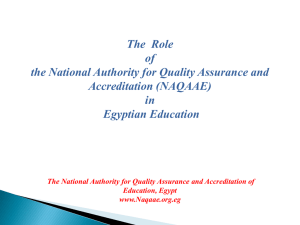Quality Teacher Education - More than accreditation
advertisement
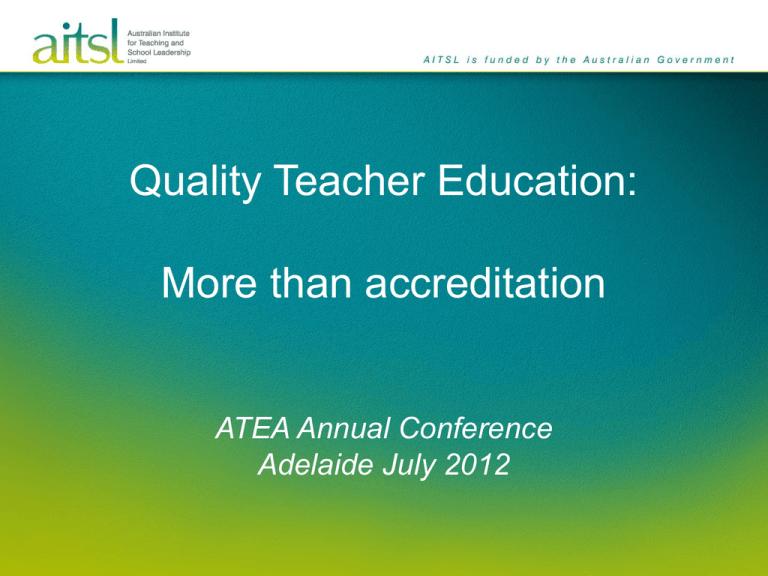
Quality Teacher Education: More than accreditation ATEA Annual Conference Adelaide July 2012 > Endorsed by MCEECDYA in April 2011 > Reflect the shared commitment of: – – – – – The teaching profession Teacher educators Employers of teachers Schools The wider education community Two key objectives: improving teacher quality through continuous improvement of initial teacher education, and accountability of providers for their delivery of quality teacher education programs, based on transparent and rigorous standards and accreditation processes. Continuous improvement Outcomes focus Flexibility, diversity and innovation Partnerships Building on existing expertise Evidence 1. National Professional Standards for Teachers (Graduate career stage) 2. National Program Standards 3. National accreditation process > Undertaken at the jurisdiction level > Based on judgments about agreed national program standards using nationally agreed procedures. > AITSL will – – – – monitor and evaluate the accreditation process nominate interstate member to each panel periodically review accreditation standards and procedures publish accreditation information and other ITE data > Further work to clarify the Program Standards and support panels in the accreditation process: – Program Standard 1 • With regulatory authorities and others, develop guidelines for assessing PST achievement against Graduate standards – Program Standard 2 • Liaising with TEQSA to align institutional accreditation and professional accreditation – Program Standard 3 • Working with curriculum authorities to identify Subject Scores that indicate literacy and numeracy achievement equivalent to the top 30 per cent of the population • Working with ACDE to develop principles, benchmarks, support and assessment for PSTs not identified as achieving in the top 30 per cent – Program Standard 4 • Working with ACECQA to develop a consolidated statement about requirements for early childhood programs • Working with regulatory authorities and others to develop agreed elaborations to clarify what the Program Standards require in priority areas, especially: – Literacy and numeracy strategies – Indigenous education – Students with special education needs – Classroom management (including bullying) – ICT in teaching – Program Standard 5 • Work with regulatory authorities, teacher educators and others to – achieve agreed clarification of concepts such as internship, enduring school partnership and sufficient evidence – identify principles for effective professional experience placements and school partnerships • Develop a professional learning tool to support teachers who provide supervision to PSTs, including assessing achievements against the NPST – Program Standard 7 • Liaise with regulatory authorities, providers and employers to clarify the nature of ITE data to be collected and/or published > Unearthing key issues affecting quality initial preparation of teachers > Current national interest and debate > Productivity Commission Schools Workforce Study Report (May 2012) – “High quality teacher education is a foundation stone of a well-performing teacher workforce” – Issues identified in initial teacher education • • • • Insufficient evidence Imbalance between teacher surplus and shortage Barriers to alternative pathways into to teaching Risks in the consistency of implementation of the national accreditation system > 2nd International Summit on the Teaching Profession (New York, March 2012) – Emphasis on: • The overarching importance of matching supply and demand • Getting the balance between theory and practice right within ITE programs • More flexibility in ITE structures without compromising the rigor of traditional routes > Queensland Review of Teacher Education and School Induction (October 2012) – Government agreed to a range of specific recommendations about the content of ITE programs and practicum > Victorian Government discussion paper: New Directions for School Leadership and the Teaching Profession (June 2012) – Improving the quality of new teacher entering the profession = 2 months improvement in student learning – Proposes raising the bar at both entry and exit – New accountability and review measures for ITE programs > NSW Minister for Education speech (June 2012) – Has commissioned paper on teacher quality – Key questions, including: • Do entrants to teacher education need more in the way of prerequisites? Not just English, what about Maths and Science? • How well do the courses deal with National Priority Areas: Special Education? Aboriginal education? Classroom management including bullying? ICT? • Who should student teachers be placed with? Any teacher who volunteers? Or a certified expert? > Opportunities for providers through engaging with the debate > Supply and demand – Quality of entrants > Quality and structure – Professional experience > Evaluation and assessment – Quality of graduates – Outcomes of programs > Diverse pathways aitsl.edu.au teacherfeature.aitsl.edu.au newsroom.aitsl.edu.au youtube.com/aitsleduau @aitsl iTunes U > Australian Institute for Teaching and School Leadership www.facebook.com/aitsl

